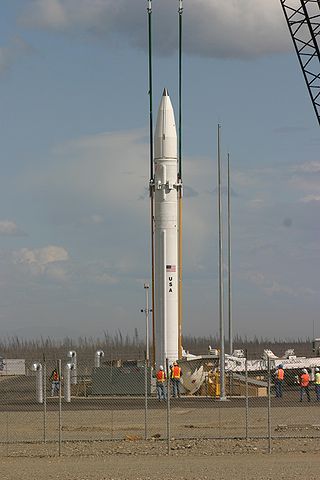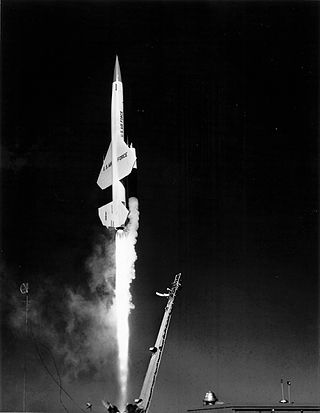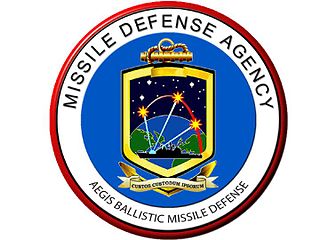
An anti-ballistic missile (ABM) is a surface-to-air missile designed to counter ballistic missiles. Ballistic missiles are used to deliver nuclear, chemical, biological, or conventional warheads in a ballistic flight trajectory. The term "anti-ballistic missile" is a generic term conveying a system designed to intercept and destroy any type of ballistic threat; however, it is commonly used for systems specifically designed to counter intercontinental ballistic missiles (ICBMs).

The Boeing CIM-10 Bomarc was a supersonic ramjet powered long-range surface-to-air missile (SAM) used during the Cold War for the air defense of North America. In addition to being the first operational long-range SAM and the first operational pulse doppler aviation radar, it was the only SAM deployed by the United States Air Force.

A missile is an airborne ranged weapon capable of self-propelled flight aided usually by a propellant, jet engine or rocket motor.

The Aegis ballistic missile defense system, also known as Sea-Based Midcourse, is a Missile Defense Agency program under the United States Department of Defense developed to provide missile defense against short and intermediate-range ballistic missiles. The program is part of the United States national missile defense strategy and European NATO missile defense system.

National missile defense (NMD) refers to the nationwide antimissile program the United States has had in development since the 1990s. After the renaming in 2002, the term now refers to the entire program, not just the ground-based interceptors and associated facilities.

Kirtland Air Force Base is a United States Air Force base. It is located in the southeast quadrant of the Albuquerque, New Mexico, urban area, adjacent to the Albuquerque International Sunport. The base was named for the early Army aviator Col. Roy C. Kirtland. The military and the international airport share the same runways, making ABQ a joint civil-military airport.

Ground-Based Midcourse Defense (GMD) is the United States' anti-ballistic missile system for intercepting incoming warheads in space, during the midcourse phase of ballistic trajectory flight. It is a major component of the American missile defense strategy to counter ballistic missiles, including intercontinental ballistic missiles (ICBMs) carrying nuclear, chemical, biological or conventional warheads. The system is deployed in military bases in the states of Alaska and California; in 2018 comprising 44 interceptors and spanning 15 time zones with sensors on land, at sea, and in orbit. In 2019, a missile defense review requested that 20 additional ground-based interceptors be based in Alaska.

The Missile Defense Agency (MDA) is a component of the United States government's Department of Defense responsible for developing a comprehensive defense against ballistic missiles. It had its origins in the Strategic Defense Initiative (SDI) which was established in 1983 by Ronald Reagan and which was headed by Lt. General James Alan Abrahamson. Under the Strategic Defense Initiative's Innovative Sciences and Technology Office headed by physicist and engineer Dr. James Ionson, the investment was predominantly made in basic research at national laboratories, universities, and in industry. These programs have continued to be key sources of funding for top research scientists in the fields of high-energy physics, advanced materials, nuclear research, supercomputing/computation, and many other critical science and engineering disciplines—funding which indirectly supports other research work by top scientists, and which was most politically viable to fund from appropriations for national defense. It was renamed the Ballistic Missile Defense Organization in 1993, and then renamed the Missile Defense Agency in 2002. The current director is U.S. Navy Vice Admiral Jon A. Hill.

The Advanced Tactical Laser (ATL) program was a US military program to mount a high energy laser weapon on an aircraft, initially the AC-130 gunship, for use against ground targets in urban or other areas where minimizing collateral damage is important. The laser was a 100 kilowatt-class chemical oxygen iodine laser (COIL). It was expected to have a tactical range of approximately twenty kilometres and weigh about 5,000–7,000 kg. This program is distinct from the Airborne Laser, which was a much larger system designed to destroy enemy missiles in the boost phase.

A chemical oxygen iodine laser (COIL) is a near–infrared chemical laser. As the beam is infrared, it cannot be seen with the naked eye. It is capable of output power scaling up to megawatts in continuous mode. Its output wavelength is 1315 nm, a transition wavelength of atomic iodine.
An airborne laser (ABL) is a laser system operated from a flying platform, as in the:

A laser weapon is a type of directed-energy weapon that uses lasers to inflict damage. Despite decades of research and development, as of 2023, directed-energy weapons, including lasers, remain at the experimental stage. Whether they will be deployed as practical, high-performance military weapons remains to be seen. One of the major issues with laser weapons is atmospheric thermal blooming, which is still largely unsolved. This issue is exacerbated when there is fog, smoke, dust, rain, snow, smog, foam, or purposely dispersed obscurant chemicals present. In essence, a laser generates a beam of light that requires clear air or a vacuum to operate.

The Boeing NC-135 and NKC-135 are special versions of the Boeing C-135 Stratolifter and Boeing KC-135 Stratotanker modified to operate on several different programs.

The Beriev A-60 is a Russian airborne laser laboratory aircraft based on the Ilyushin Il-76MD transport— it was originally developed in the former Soviet Union for its airborne forces.

Hypersonic flight is flight through the atmosphere below altitudes of about 90 km at speeds greater than Mach 5, a speed where dissociation of air begins to become significant and high heat loads exist. Speeds over Mach 25 have been achieved below the thermosphere as of 2020.
The Space Tracking and Surveillance System was a pair of satellites developed by the United States Missile Defense Agency (MDA) to research the space-based detection and tracking of ballistic missiles. Data from STSS satellites could allow interceptors to engage incoming missiles earlier in flight than would be possible with other missile detection systems. The STSS program began in 2001, when the "SBIRS Low" program was transferred to MDA from the United States Air Force. In December 2002, SBIRS Low Research & Development was renamed Space Tracking and Surveillance System (STSS).

The 417th Flight Test Squadron is an active United States Air Force squadron. It is assigned to the 96th Operations Group at Eglin Air Force Base, Florida, where it was reactivated on 17 April 2019.

The 452d Flight Test Squadron is a United States Air Force squadron. It is assigned to the 412th Operations Group, Air Force Materiel Command, stationed at Edwards Air Force Base, California.

The Boeing Phantom Eye was a high altitude, long endurance (HALE) liquid hydrogen-powered unmanned aerial vehicle developed by Boeing Phantom Works. The aircraft was Boeing's proposal to meet the demand from the US military for unmanned drones designed to provide advanced intelligence and reconnaissance work, driven by the combat conditions in Afghanistan in particular. In August 2016, the Phantom Eye demonstrator was disassembled for display at the Air Force Flight Test Museum.
In air and missile defense (AMD), the Integrated Air-and-Missile Defense system (IAMD) is an SMDC research program to augment the aging surface-to-air missile defense systems and to provide the United States Army with a low-cost, but effective complement to kinetic energy solutions to take out air threats. Brigade level higher energy lasers are used in truck mounted systems called HELMTT. At lower levels, the Army needs to develop interceptors that don't cost more than small, unmanned aircraft systems. In early research they have successfully used 5-kilowatt lasers on a Stryker combat vehicle. The Mobile Expeditionary High-Energy Laser (MEHEL) was used at MFIX at Fort Sill, Oklahoma, in the first half of April, 2017.






















